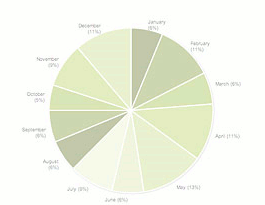


Getting to the Critical Threshold for Women in Computer Science
Hi friends of women in science,
Sonia Pressman Fuentes recently alerted me to an interesting article on women in computer science that appeared in the Washington Post, by Anna Holmes. You can read it here. The article traces some of the recent reports on women in science, including the one coauthored for AAUW by Christianne Corbett, my co-forum host on this blog. She also quotes Nancy Ramsey, author of The Futures of Women: Scenarios for the 21st Century, who said, "This is a national crisis." Her main focus in concluding that was the low and decreasing percentage of computer scientists who are female. She also cites the Department of Commerce report and Department of Labor statistics that we have touched on, showing that women hold less than 25% of the jobs in STEM fields, although they hold about half of all jobs in the US. Women's proportion declined from 30% to 27% between 2000 and 2009 in computer science/information technology, a field that is projected to provide a major share of new jobs in the future. As Corbett pointed out, without women at the tables designing computer programs and computers, the interests and needs of women in information technology will most likely be ignored.
Holmes noted features of society that reinforce stereotypes. directing women away from science and setting up conflicts between science and sexual attractiveness. She cites an interesting study of Orit Hazzan in Israel, of high school students taking AP Computer Science in Hebrew-speaking or Arabic-speaking schools. Interestingly, in the Hebrew-speaking schools, about 27% girls were registered in AP Computer Science. In the Arabic-speaking schools, it was 61% girls. For comparison, in the US 19% of the students taking the AP test in Computer Science are female. The explanation appears to be cultural acceptance/expectations of girls that direct them away from mathematics. And Holmes points to a new study by the Geena Davis Institute that shows in American G-rated films, those seen by young children, women were not shown in STEM jobs at all in films released between 2006 and 2009.
Holmes suggests that when the women reach about a third of the population in a male-dominated field, the atmosphere for women becomes much more comfortable. And some good signs of change are appearing. For example, at Carnegie Mellon, 32% of the incoming class in this field were women this year. There was a smaller increase, but at least an incrase at Stanford as well. So perhaps things are improving. But as we know, nurturing and attention still are needed to make sure these women remain comfortable in their chosen major and persist in the field.
Cheers,
Laura

I do some biomath and it seems to me that when there are just a few biomath guys present, I"m fine. It's just when they get up to about 8-10 that they start with the frat man behavior. So to me, the number rather than the percentage matters more.
I think that it's about a fourth you need before men are aware enough to stop making sexist comments. Before that they look around an snicker, then go ahead. If you have a third, there may be some other behavior that becomes less likely, but I haven't seen it. I think the threshhold for removing nudes from the walls is probably higher, maybe half. You may need a certain number before you by accident get someone feisty, perhaps. They aren't so common.
SW
Hi Elizabeth,
Yes, Malasia. The article about Israeli schools was only cited in passing but I am going to try to get hold of it and read more about the study. What this article said was the Arabic-speakers thought CS presented more of an opportunity for girls. It's a very interesting dichotomy, it seems to me.
cheers,
Laura
Hi Laura,
I remember we discussed the situation in Malasia? Indonesia? One of the two, and there was peer pressure and family pressure for women to go into CS because it was clean and safe. Did they talk about the difference between Hebrew- and Arabic-speaking AP students in terms of their reasons for encouraging/discouraging CS for girls?
ELC

















